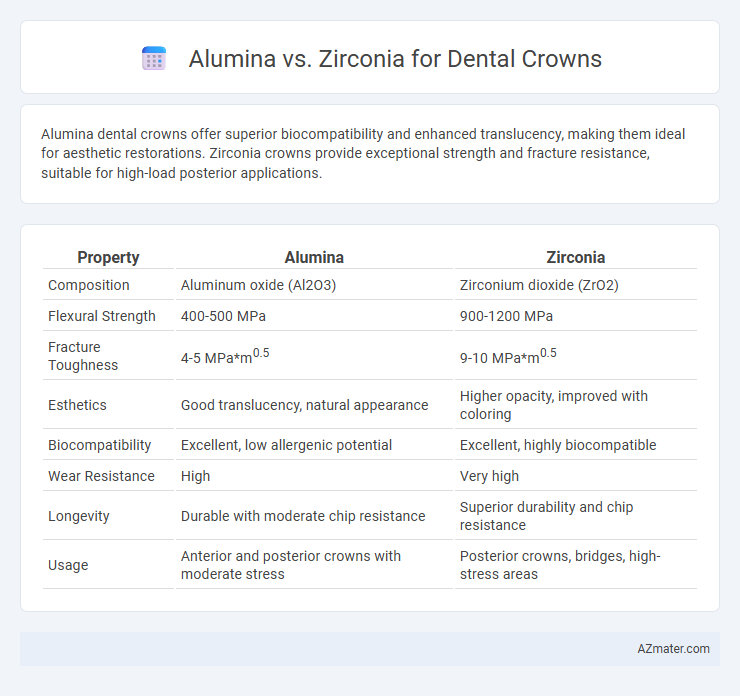Alumina dental crowns offer superior biocompatibility and enhanced translucency, making them ideal for aesthetic restorations. Zirconia crowns provide exceptional strength and fracture resistance, suitable for high-load posterior applications.
Table of Comparison
| Property | Alumina | Zirconia |
|---|---|---|
| Composition | Aluminum oxide (Al2O3) | Zirconium dioxide (ZrO2) |
| Flexural Strength | 400-500 MPa | 900-1200 MPa |
| Fracture Toughness | 4-5 MPa*m0.5 | 9-10 MPa*m0.5 |
| Esthetics | Good translucency, natural appearance | Higher opacity, improved with coloring |
| Biocompatibility | Excellent, low allergenic potential | Excellent, highly biocompatible |
| Wear Resistance | High | Very high |
| Longevity | Durable with moderate chip resistance | Superior durability and chip resistance |
| Usage | Anterior and posterior crowns with moderate stress | Posterior crowns, bridges, high-stress areas |
Introduction to Dental Crown Materials
Alumina and zirconia are prominent ceramic materials used in dental crowns due to their exceptional strength and biocompatibility. Alumina offers high translucency and wear resistance, making it suitable for aesthetic anterior restorations, while zirconia provides superior fracture toughness and durability ideal for posterior crowns. Both materials enhance the longevity and functionality of dental restorations, with zirconia often preferred for its balance of strength and natural appearance.
Overview of Alumina and Zirconia
Alumina and zirconia are two widely used ceramic materials in dental crowns, valued for their strength and biocompatibility. Alumina crowns offer excellent translucency and esthetics due to their high alumina oxide content, making them suitable for anterior teeth restorations. Zirconia crowns provide superior fracture toughness and durability with a dense crystalline structure, often preferred for posterior teeth and implant-supported crowns.
Mechanical Properties: Strength and Durability
Zirconia exhibits superior mechanical strength and fracture toughness compared to alumina, making it more resistant to cracking and chipping under masticatory forces. Alumina offers good hardness and wear resistance but has lower flexural strength, which can limit its durability in high-stress dental crown applications. The enhanced durability and shock absorption of zirconia crowns contribute to their increasing preference for long-lasting restorative dental solutions.
Esthetics: Transparency and Color Matching
Alumina crowns offer superior translucency, closely mimicking natural tooth enamel and enhancing esthetic outcomes in dental restorations. Zirconia crowns, while highly durable, exhibit less transparency but can be layered with porcelain to improve color matching and achieve a natural appearance. Advanced multi-layered zirconia formulations now balance strength and esthetics, providing improved translucency and customizable shades for optimal integration with adjacent teeth.
Biocompatibility and Safety
Alumina and zirconia are both highly biocompatible materials used in dental crowns, offering excellent tissue compatibility and low risk of allergic reactions. Zirconia exhibits superior fracture toughness and wear resistance, making it safer for long-term dental restorations under high masticatory forces. Alumina, while slightly less durable, provides excellent esthetics and minimal plaque accumulation, enhancing oral health safety.
Wear Resistance and Longevity
Zirconia crowns exhibit superior wear resistance compared to alumina, making them more durable for long-term dental restorations. Alumina crowns, while biocompatible and aesthetic, tend to wear faster under masticatory forces, potentially reducing their longevity. Clinical studies show zirconia dental crowns maintain structural integrity and functionality over extended periods, often exceeding 10 years with minimal surface degradation.
Clinical Performance and Success Rates
Alumina crowns demonstrate strong biocompatibility and high fracture toughness, making them suitable for anterior restorations with a clinical success rate exceeding 90% over five years. Zirconia crowns offer superior strength and wear resistance, supporting reliable performance in both anterior and posterior teeth, with success rates reported up to 95% over similar periods. Both materials provide excellent marginal adaptation and low plaque accumulation, but zirconia's enhanced mechanical properties contribute to greater long-term durability in high-stress occlusal environments.
Cost Comparison: Alumina vs Zirconia
Alumina dental crowns typically cost between $800 and $1,200 per crown, offering a more affordable option compared to zirconia crowns, which range from $1,000 to $2,500 each. The price difference is influenced by zirconia's superior strength, durability, and esthetic qualities, making it a preferred choice for molars and longer-lasting restorations despite the higher upfront cost. Insurance coverage and geographic location also affect the final cost, with zirconia crowns often receiving better long-term value due to lower replacement rates.
Indications and Contraindications
Alumina dental crowns are indicated for patients requiring high biocompatibility and translucency, making them ideal for front teeth restorations and individuals with metal allergies. Zirconia crowns are preferred for posterior teeth due to their superior strength and fracture resistance, suitable for patients with bruxism or heavy occlusal forces. Contraindications for alumina include use in high-stress areas where mechanical strength is critical, while zirconia is contraindicated in cases requiring maximal esthetics due to its lower translucency compared to alumina.
Choosing the Right Material for Dental Crowns
Alumina dental crowns offer excellent biocompatibility and translucency, making them suitable for anterior teeth with moderate strength requirements. Zirconia crowns provide superior strength and durability, ideal for posterior teeth that endure high biting forces and require long-lasting performance. Selecting between alumina and zirconia depends on factors such as location of the crown, aesthetic demands, and patient-specific functional needs.

Infographic: Alumina vs Zirconia for Dental Crown
 azmater.com
azmater.com